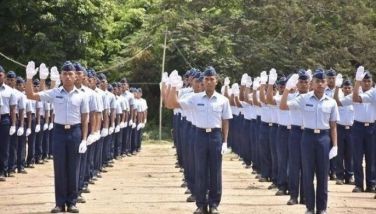Chinese warn off CAAP flight
MANILA, Philippines – Philippine officials say they received two intimidating radio warnings from people who identified themselves being from the Chinese navy when they flew a Cessna plane close to a Chinese-constructed island in the South China Sea.
Eric Apolonio said the incident happened Jan. 7 when he and other personnel of the Civil Aviation Authority of the Philippines (CAAP) flew to the Palawan town of Pag-asa for an engineering survey ahead of the planned installation of aviation safety equipment on the island.
Pag-asa is close to Subi Reef, which has been transformed by China into an island in the disputed Spratly chain.
Apolonio said the voice message warned that the aircraft was “threatening the security of our station.” He said they continued their trip.
“The foreign ministry has been informed about the reported incident involving our civil aviation team,” presidential spokesman Herminio Coloma told reporters, adding that the foreign ministry was expected to make a statement on the matter.
The Philippine civil aviation agency has limited radar coverage and the military is expected to sign a deal this year for three aerial radars to detect airspace intrusions as far as 402 km away, beyond the exclusive economic zone.
The Philippines plans to install a $1-million satellite-based system to track commercial flights over the disputed South China Sea, after China landed its first test flights this month on a reef it built in the Spratly islands.
China’s increasing military presence in the Spratlys has stirred fears it could lead to an air defense zone the country controls, which would escalate tension with other claimants, and the United States, in one of the world’s most volatile areas.
China claims almost the entire South China Sea, believed to have huge oil and gas deposits, but Brunei, Malaysia, the Philippines, Taiwan and Vietnam also have claims in the sea, through which about $5 trillion in trade passes every year.
“In the absence of a radar in the area, the system will help track aircraft movements, enhancing safety and security,” said Rodante Joya, a deputy director-general of the Civil Aviation Authority of the Philippines.
Joya said the Philippines would install the P50-million ($1.05-million) surveillance system on the Philippine-occupied Pagasa Island (Thitu), to track about 200 commercial flights through the area each day.
The area in the South China Sea is among the blind spots in the Philippines’ airspace, he added.
The Philippines and Vietnam protested against China’s test flights on the Fiery Cross reef this month, saying Beijing might impose an air defense identification zone, restricting flights by commercial airlines over the South China Sea.
Joya said the agency was waiting for approval from security and foreign affairs officials as the tracking system, or automatic dependent surveillance broadcast system, as it is called, is to be located on a military base in a disputed area.
Seven civil aviation radar stations will also be added, he said.
- Latest
- Trending































